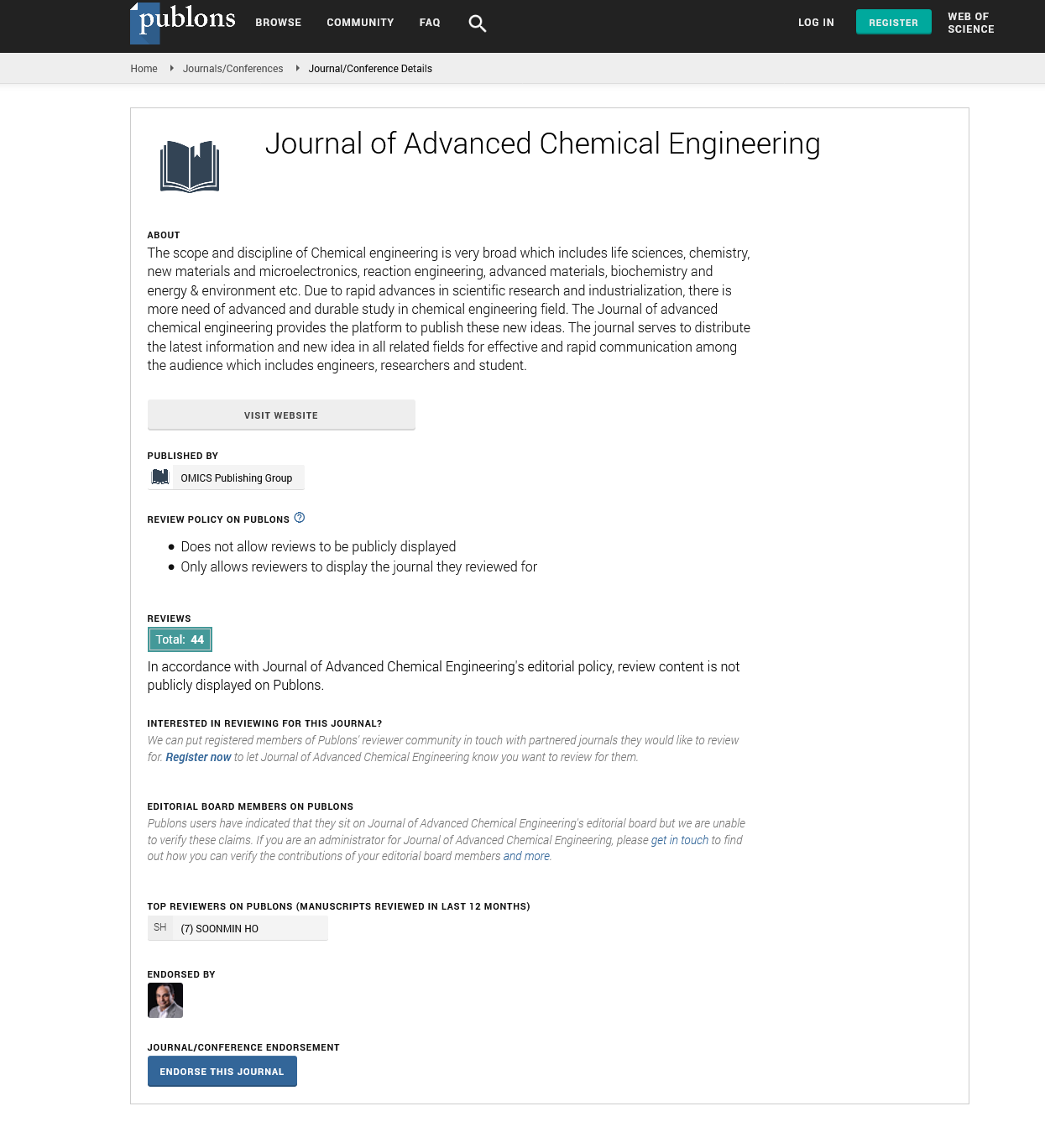Indexed In
- Open J Gate
- Genamics JournalSeek
- Smithers Rapra
- RefSeek
- Directory of Research Journal Indexing (DRJI)
- Hamdard University
- EBSCO A-Z
- OCLC- WorldCat
- Scholarsteer
- Publons
- Geneva Foundation for Medical Education and Research
- Google Scholar
Useful Links
Share This Page
Journal Flyer

Open Access Journals
- Agri and Aquaculture
- Biochemistry
- Bioinformatics & Systems Biology
- Business & Management
- Chemistry
- Clinical Sciences
- Engineering
- Food & Nutrition
- General Science
- Genetics & Molecular Biology
- Immunology & Microbiology
- Medical Sciences
- Neuroscience & Psychology
- Nursing & Health Care
- Pharmaceutical Sciences
Perspective - (2023) Volume 13, Issue 1
Aerosol Mass Spectroscopy: It's Characteristics and Instrumentation
Jipin Xi*Received: 03-Feb-2023, Manuscript No. ACE-23-19712; Editor assigned: 06-Feb-2023, Pre QC No. ACE-23-19712 (PQ); Reviewed: 21-Feb-2023, QC No. ACE-23-19712; Revised: 28-Feb-2023, Manuscript No. ACE-23-19712 (R); Published: 07-Mar-2023, DOI: 10.35248/2090-4568.23.13.269
Description
In addition to limiting visibility and having a negative impact on human health, aerosols have a substantial impact on the chemistry and radiative balance of the Earth's atmosphere. Instrumentation that is capable of reporting the chemical and microphysical characteristics of ambient particles is required to address the effects of aerosols on the environment and human health. Aerosol instrumentation that is easy to use, capable of long-term, autonomous, steady operation, and providing results in real time is also sought from the perspective of air quality monitoring.
It is discussed how to do research on the chemistry of atmospheric aerosols using a cutting-edge chamber facility. For the purpose of simulating possible aerosol generation air conditions, two 28 m3 Fluorinated Ethylene Propylene (FEP) Teflon film chambers are used. This facility gives researchers the freedom to examine both whole photochemical simulations and dark, single oxidant reactions. In order to track the creation and expansion of atmospheric aerosols, gas-phase and aerosol-phase sensors are both covered in this work. There are ways for estimating secondary organic aerosol production during reaction as well as physical events taking place in the chamber that are explained. They offer methods for the generation and evolution of aerosols under various relative humidity situations.
Throughout numerous week-long field experiments from 2002 to 2009, real-time measurements of non-refractory submicron aerosols were made throughout the larger Alpine region (Switzerland, Germany, Austria, France, and Liechtenstein).
One of the most significant economic and recreational areas in Europe is represented by this area. A wide range of locations were examined, including urban settings, highways, rural areas, isolated locations, high-alpine stations, and mobile on-road measurements. Aerosol mass spectrometry was used to determine the inorganic and Organic Aerosol (OA) fractions. For the purpose of improving the temporal and spatial data coverage, data from 13 separate field campaigns have been integrated.
For the various campaigns, the usual Non Refractory Particulate Matter (NR-PM1) mass concentration ranged between 10 and 30 g/m3. From 36% to 81% of NR-PM1, the organic part was more prevalent overall. Ammonium (5%–15%), nitrate (8%–36%), sulphate (3%-26%), and chloride (0%–5%) made up the remaining principal components. Ammonium, on average, completely neutralized these latter anions. As a notable outcome, it was discovered that the location of the site and the time of year (winter vs. summer) were better predictors of aerosol composition than the kind of site and could account for a large portion of the variation in aerosol chemical composition for the various campaigns (urban, rural etc.). As a result, a review of measurement site categories may be undertaken in the future, maybe also for other parts of the world.
The Aerosol Chemical Speciation Monitor (ACSM) is a regular tool for characterizing and continuously monitoring the mass and chemical make-up of non-refractory submicron particulate matter. Mass concentrations of particulate organics, sulphate, nitrate, ammonium, and chloride are measured in ambient settings with detection limits of less than 0.2 g/m3 for 30 minutes of signal averaging. The Aerodyne Aerosol Mass Spectrometer (AAMS), which combines an aerodynamic particle focusing lens with high vacuum thermal particle vaporization, electron impact ionization, and mass spectrometry, provides the technology foundation for the ACSM.
However, changes to the ACSM’S design allow it to be more compact, less expensive, and easier to use than the AMS. The ACSM can also maintain regular stability for extended periods of time (months). The findings of a field measurement campaign in Queens, New York, where the ACSM ran constantly and unsupervised for eight weeks, are given. The same sophisticated methods that are employed for AMS data analysis are also applied for ACSM data analysis. When compared to trends from co-located instruments, the Queens, New York study's ACSM mass concentration trends are excellent. Hydrocarbon-like Organic Aerosol (HOA) and oxygenated organic aerosol are the two components that Positive Matrix Factorization (PMF) of the ACSM organic aerosol spectra isolates (OOA).
Citation: Xi J (2023) Aerosol Mass Spectroscopy: It’s Characteristics and Instrumentation. Adv Chem Eng. 13:269.
Copyright: © 2023 Xi J. This is an open-access article distributed under the terms of the Creative Commons Attribution License, which permits unrestricted use, distribution, and reproduction in any medium, provided the original author and source are credited.

